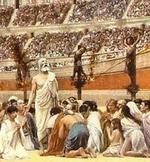"But does it matter how I happen to be dressed...?"
By ( articles ) | May 26, 2004
Free eBook:

|
| Free eBook: Essays in Apologetics, Vol. II |
Why should a priest refuse communion to a congregant who approaches him wearing a rainbow sash?
Jewish men are required to cover their heads on entering a synagogue. Consider the case of a man who tries to enter a synagogue on the feast of Simhat Torah wearing a Nazi stahlhelm. Most of us would think the elders justified in refusing him entrance. Why? Because bending steel in a particular way impedes worship of God? No, because the elders understand the stahlhelm precisely as it is meant to be understood by its wearer, as an expression of contempt for Jews and Judaism. The key point is the mutually recognized intention in the wearing of a Nazi icon.
Prof. Michael Levin writes: "Just as reference is secured by a mutually recognized intention to refer ... so an insult is a word or a gesture used with the intention of causing affront through the recognition of that intention."
Would the situation change if the person wearing the Nazi helmet were himself Jewish? Only to the extent that one would acknowledge more complex psychological motivations behind the intention to express contempt. We can imagine a 17-year-old Jewish boy who showed up on Simhat Torah in a Nazi helmet, and most of us would intuitively recognize that there must be some deep-seated anger (directed at a parent, perhaps) at the bottom of the desire to wound, and consequently we might interpret the action as the product of pain and confusion rather than of true hatred. But the desire to wound is there for all that, and must be recognized. To allow the boy to attend services wearing the helmet would be grotesquely irresponsible indulgence.
Wearing a rainbow sash at mass likewise is an action with a mutually recognized intention, in this case, that of expressing defiance of the Catholic Church's teaching against homosexual acts. It is not, of course, the equivalent of a perfectly univocal statement, any more than wearing a Nazi helmet is a univocal statement, but the intended expression of defiance is not in doubt.
Therefore: I do not refuse this rainbow-sashed man communion because the sash implies that he is an unshriven sodomite. I refuse him communion because the sash unambiguously expresses his defiance and rejection of Church doctrine, and, by entailment, his rejection of the Church as a reliable teacher of God's law, and, by entailment, his apostasy
All comments are moderated. To lighten our editing burden, only current donors are allowed to Sound Off. If you are a current donor, log in to see the comment form; otherwise please support our work, and Sound Off!






